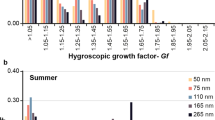Abstract
A method is suggested for determining the mass concentration of airborne particles with sizes ≤1, ≤2.5, ≤10, and >10 μm by measuring the light scattering coefficients of the investigated air at the wavelengths λ1 ≤ 0.55 and λ2 ≥ 1.0 μm for the scattering angles θ1 ≤ 5° and θ2 = 15–45°. Mass concentrations of airborne particles are calculated on the basis of their stable statistical relationships with measured coefficients. Analytical expressions for approximation of these statistical relationships have been derived on the basis of an optical-microphysical model of urban aerosol, adopted by the World Meteorological Organization, with variable concentrations, size distribution parameters, and complex refractive index of the particles of aerosol components (soot, water-soluble, and dust). Statistical relationships derived in the modeling approach have been compared with independent numerical and experimental data. The errors of the method developed have been assessed under the overall variability of urban aerosol microphysical parameters.
Similar content being viewed by others
References
A. P. Waggones, R. E. Weiss, N. C. Ahlquist, D. S. Covert, S. Will, and R. J. Charlson, “Optical characteristics of atmospheric aerosols,” Atmos. Environ. 15(10/11), 1891–1909 (1981).
M. A. Sviridenkov, A. S. Emilenko, A. A. Isakov, and V. M. Kopeikin, “Comparison of black carbon content, aerosol optical and microphysical characteristics in Moscow and the Moscow region,” in Proc. Fifteenth ARM Science Team Meeting, Daytona Beach, Florida, March, 14–18, 2005, pp. 140–147.
J. Jung, H. Lee, J. J. Kim, X. Liu, Y. Zhang, M. Hu, and N. Sogimoto, “Optical properties of atmospheric aerosols obtained by in situ and remote measurements during 2006 campaign of air quality research in Bei**g,” J. Geophys. Res. 114, D00G02 (2009). doi: 10.1029/2008JD010337
S. A. Lysenko and M. M. Kugeiko, “Retrieval of the mass concentration of dust in industrial emissions from optical sensing data,” Atmos. Ocean. Opt. 25(1), 35–43 (2012).
S. A. Lisenko and M. M. Kugeiko, “Spectronephelometric methods to determine microphysical characteristics of dust in aspiration air and off-gases in cement plants,” J. Appl. Spectrosc. 79(1), 59–69 (2012).
V. E. Zuev and V. S. Komarov, Statistical Models of Temperature and Gas Components of the Earth’s Atmosphere (Gidrometeoizdat, Leningrad, 1986) [in Russian].
World Climate Research Programme: A preliminary cloudless standard atmosphere for radiation computation, Report WCP-112, WMO/TD-24 (World Meteorological Organization, Geneva, 1986).
ISO13320, Particle size analysis—Laser diffraction methods, 2009.
B. Veihelmann, M. Konert, and W. J. van der Zande, “Size distribution of mineral aerosol: Using light-scattering models in laser particle sizing,” Appl. Opt. 45(23), 6022–6029 (2006).
V. V. Barun, A. P. Ivanov, and F. P. Osipenko, “Peculiarities in spectral behavior of optical characteristics of urban aerosols by laser sensing data and model estimations,” Proc. SPIE—Int. Soc. Opt. Eng. 3983, 279–289 (1999).
V. M. Zolotarev, V. N. Morozov, and E. V. Smirnov, Optical Constants of Natural and Technical Media (Khimiya, Leningrad, 1984) [in Russian].
V. E. Zuev and G. M. Krekov, Optical Models of the Atmosphere (Gidrometeoizdat, Leningrad, 1986) [in Russian].
L. S. Ivlev and S. D. Andreev, Optical Properties of Atmospheric Aerosols (Izd. LGU, Leningrad, 1986) [in Russian].
G. M. Krekov and S. G. Zvenigorodskii, Optical Model of the Middle Atmosphere (Nauka, Novosibirsk, 1990) [in Russian].
G. A. d’Almeida, P. Koepke, and E. Shettle, Atmospheric Aerosols: Global Climatology and Radiative Characteristics (A. Deepak Publishing, Hampton, USA, 1991).
L. S. Rothman, C. P. Rinsland, A. Goldman, S. T. Massie, D. P. Edwards, J.-M. Flaud, A. Perrin, C. Camy-Peyret, V. Dana, J.-Y. Mandin, J. Schroeder, A. Mccann, R. R. Gamache, R. B. Watson, K. Yoshino, K. V. Chance, K. W. Jucks, L. R. Brown, V. Nemtchinov, and P. Varanasi, “The HITRAN Molecular Spectroscopic Database and Hawks (HITRAN Atmospheric Workstation): 1996 EDITION,” J. Quant. Spectrosc. Radiat. Transfer 60(5), 665–710 (1998).
K. Ya. Kondrat’ev, N. I. Moskalenko, and D. V. Pozdnyakov, Atmospheric Aerosol (Gidrometeoizdat, Leningrad, 1983) [in Russian].
M. I. Mishchenko, L. D. Travis, and A. A. Lacis, Scattering, Absorption, and Emission of Light by Small Particles (NASA Goddard Institute for space studies, New York, 2004).
M. A. Sviridenkov, “Van de Hulst approximation and dust aerosol microstructure,” Izv. RAN, Fiz. Atmosf. Okeana 29(2), 218–221 (1993).
V. V. Pol’kin, Yu. V. Artamonov, V. P. Bunyakin, and S. P. Kislitsyn, “Spatial features of distribution of atmospheric aerosol and hydrometeorological parameters from data of measurements at’ Akademik Fedorov’ RV in 2009,” Sistemy Kontrolya Okruzhayushchei Sredy, No. 13, 146–152 (2010).
A. Trier, N. Cabrini, and J. Ferrer, “Correlations between urban atmospheric light extinction coefficients and particle mass concentrations,” Atmosf. 10(3), 151–160 (1997).
M. Adam, M. Pahlow, V. Kovalev, J. M. Ondov, M. B. Parlange, and N. Nair, “Aerosol optical characterization by nephelometer and lidar: The Baltimore supersite experiment during the Canadian forest fire smoke intrusion,” J. Geophys. Res. 109, D16502 (2004). doi 10.1029/2003JD004047
A. A. Glazkova, I. N. Kuznetsova, I. Yu. Shalygina, and E. G. Semutnikova, “Daily variations in the aerosol concentration (PM10) in summer in Moscow region,” Opt. Atmosf. Okeana 25(6), 495–500 (2012).
Author information
Authors and Affiliations
Corresponding author
Additional information
Original Russian Text © S.A. Lisenko, M.M. Kugeiko, 2014, published in Optika Atmosfery i Okeana.
Rights and permissions
About this article
Cite this article
Lisenko, S.A., Kugeiko, M.M. Nephelometric method for measuring mass concentrations of urban aerosols and their respirable fractions. Atmos Ocean Opt 27, 587–595 (2014). https://doi.org/10.1134/S102485601406013X
Received:
Published:
Issue Date:
DOI: https://doi.org/10.1134/S102485601406013X




